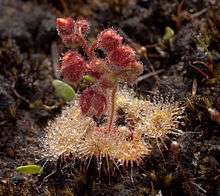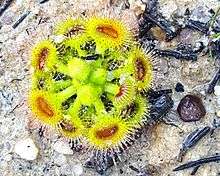Drosera glanduligera
Drosera glanduligera, the pimpernel sundew,[1] is a rosetted annual species in the carnivorous plant genus Drosera that is endemic to Australia. It is 2.5–6 cm (1–2 in) tall and grows in most soil conditions. It produces orange flowers from August to November. It was originally described in 1844 by Johann Georg Christian Lehmann.[1] It is the sole species in the subgenus Coelophylla, which Jan Schlauer elevated from section rank in 1996; it was originally described by Jules Émile Planchon in 1848.[2]
| Drosera glanduligera | |
|---|---|
 | |
| Drosera glanduligera growing on the foothills of Mount Cameron, in northeastern Tasmania, Australia | |
| Scientific classification | |
| Kingdom: | Plantae |
| Clade: | Tracheophytes |
| Clade: | Angiosperms |
| Clade: | Eudicots |
| Order: | Caryophyllales |
| Family: | Droseraceae |
| Genus: | Drosera |
| Subgenus: | Drosera subg. Coelophylla (Planch.) Schlauer |
| Species: | D. glanduligera |
| Binomial name | |
| Drosera glanduligera | |
| Synonyms | |
Distribution
Drosera glanduligera is native to Tasmania and south western and south eastern Australia where it is often locally abundant.[3]
Biology
Drosera glanduligera is an annual plant that grows in the winter. Germination of the seeds requires cold temperatures. Young plants eat springtails while larger plants eat flies.[3]
The trapping mechanism of this species is unique in that it combines features of both flypaper and snap traps; it has been termed a catapult-flypaper trap.[4] Non-flying insects trigger this catapult when certain plant cells break.[5] Then this process cannot be repeated until the plant grows new tentacles.[5]

Cultivation
Drosera glanduligera can be a difficult plant to cultivate, mainly due to its stringent temperature requirements, both for germination and further growth.[6] Plants (especially seedlings) must be fed regularly in order to maintain vigour.[6] The plant grows well in standard carnivorous plant soil mixes.[6]
See also
References
- "Drosera glanduligera". FloraBase. Western Australian Government Department of Parks and Wildlife.
- Schlauer, Jan (1996). "A dichotomous key to the genus Drosera L. (Droseraceae)" (PDF). Carnivorous Plant Newsletter. 25: 67–88.
- Brittnacher, J. Growing Drosera glanduligera. Archived 29 January 2015 at the Wayback Machine International Carnivorous Plant Society. Retrieved on 29 Jan 2015
- Poppinga, S.; Hartmeyer, S.R.H.; Seidel, R.; Masselter, T.; Hartmeyer, I.; Speck, T. (2012). "Catapulting tentacles in a sticky carnivorous plant". PLoS ONE. 7 (9): e45735. doi:10.1371/journal.pone.0045735. PMC 3458893. PMID 23049849.
- "Scientists discover carnivorous plant using sticky catapulting tentacles". University of Freiburg. Science Network: Western Australia. 21 November 2012. Archived from the original on 31 December 2012. Retrieved 29 November 2012.
- "Growing Drosera glanduligera | ICPS". www.carnivorousplants.org. Retrieved 3 June 2020.
| Wikimedia Commons has media related to Drosera glanduligera. |